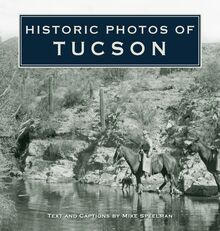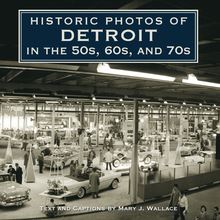Historic Photos of Las Vegas , livre ebook
159
pages
English
Ebooks
2007
Vous pourrez modifier la taille du texte de cet ouvrage
Obtenez un accès à la bibliothèque pour le consulter en ligne En savoir plus
Découvre YouScribe en t'inscrivant gratuitement
Découvre YouScribe en t'inscrivant gratuitement
159
pages
English
Ebooks
2007
Vous pourrez modifier la taille du texte de cet ouvrage
Obtenez un accès à la bibliothèque pour le consulter en ligne En savoir plus
Publié par
Date de parution
01 novembre 2007
Nombre de lectures
0
EAN13
9781618586476
Langue
English
Poids de l'ouvrage
11 Mo
Las Vegas—a Spanish word meaning "The Meadows" or "The Grasslands"—was established as a railroad town in 1905 and was officially incorporated in 1911. It is the largest city in the United States founded in the 20th century and goes by the two different nicknames of "The Entertainment Capital of the World" and "Sin City".
Las Vegas continues to evolve: the city legalized gambling in 1936, Bugsy Siegel's Flamingo Hotel opened in 1946 starting the now infamous Las Vegas Strip, and Steve Wynn opened The Mirage in 1989 starting a new era with the megaresort casinos. This book follows life, government, events and people important to Las Vegas history and the building of this unique city.
Spanning over two centuries and two hundred photographs, this is a must have for any long-time resident or history lover of Las Vegas!
Publié par
Date de parution
01 novembre 2007
Nombre de lectures
0
EAN13
9781618586476
Langue
English
Poids de l'ouvrage
11 Mo
HISTORIC PHOTOS OF
LAS VEGAS
T EXT AND C APTIONS BY J EFF B URBANK
Early visitors would never have believed Nevada s rugged landscape would give birth to a dazzling city of lights, gambling, and entertainment, famous around the world.
HISTORIC PHOTOS OF
LAS VEGAS
Turner Publishing Company
200 4th Avenue North Suite 950
Nashville, Tennessee 37219
(615) 255-2665
www.turnerpublishing.com
Historic Photos of Las Vegas
Copyright 2007 Turner Publishing Company
All rights reserved.
This book or any part thereof may not be reproduced or transmitted in any form or by any means, electronic or mechanical, including photocopying, recording, or by any information storage and retrieval system, without permission in writing from the publisher.
Library of Congress Control Number: 2007929569
ISBN: 978-1-59652-380-7
Printed in China
09 10 11 12 13 14 15 16-0 9 8 7 6 5 4 3
C ONTENTS
A CKNOWLEDGMENTS
P REFACE
R ISE OF A R AILROAD B OOMTOWN (1904-1910)
B EFORE H OOVER D AM : M OLDING A D ESERT C OMMUNITY (1911-1929)
H OOVER D AM , G AMING, AND THE E ARLY L AS V EGAS S TRIP (1930-1949)
M ODERN L AS V EGAS T AKES S HAPE (1950-1969)
N OTES ON THE P HOTOGRAPHS
The dealer of a roulette game at the Apache bar on Fremont Street pushes stacks of casino chips toward a winning gambler, late 1930s to 1940s.
A CKNOWLEDGMENTS
This volume, Historic Photos of Las Vegas , is the result of the cooperation and efforts of many individuals, organizations, and corporations. It is with great thanks that we acknowledge the valuable contribution of the following for their generous support:
University of Nevada Las Vegas Libraries, Special Collections
We would also like to thank the following individuals for valuable contributions and assistance in making this work possible:
Peter Michel, Director, University of Nevada Las Vegas Libraries, Special Collections
P REFACE
The photographs in this book are organized into four chronological sections. The first section, Rise of a Railroad Boomtown, covers the founding years of Las Vegas, 1904 to 1910, from before the 1905 land auction that formed the town to the launch of the railroad through town and the creation of Clark County in 1909. The images depict the will and pioneer spirit of the early settlers at a time when they had to survive day-to-day in a sparse, desert environment that is alternately hot and cold. They reveal how rapidly both the McWilliams and Clark townsites were built so that the residents could begin their new lives, and how those residents coped as a community under harsh, crude living conditions.
The second section, Before Hoover Dam: Molding a Desert Community, includes pictures taken in the years 1911 to 1929, during which Las Vegas began to mature as an incorporated city with stores, parks, schools, banks and paved streets. Residents would later experience the loss of much of their railroad supply business, but in the 1920s they experienced elation when the U.S. government decided to build the Hoover Dam project, which guaranteed the city s future expansion and prosperity.
The crucial decade of the 1930s is key to the third section, Hoover Dam, Gaming, and the Early Las Vegas Strip, covering 1930 to 1949. In the 1930s, Hoover Dam was completed, Nevada legalized casinos, the federal government ended Prohibition, and Las Vegas truly began to take off as a relaxing spot for tourists to visit on their way to see the famous, spectacular new dam. The group of photos also reveals how Las Vegas looked in the 1940s, when military spending during World War II brought another economic boom, and the first resorts were established on the fledgling Las Vegas Strip between 1941 and 1948.
Finally, in Modern Las Vegas Takes Shape, from 1950 to 1969, the images follow the progress the city and county made during the resort boom of the 1950s, its contribution to-and benefits from-the Cold War, and the amazing growth of its visitor economy into the 1960s, which set up the incredible population growth and development that would come in later decades.
The Las Vegas shown in these photographs brings to light the city s changing scenery, its many booms versus few busts, and the evolution of what became the largest city in the United States to be entirely created and developed during the twentieth century.
- Jeff Burbank, Author
This project represents countless hours of review and research. The researchers and writer have reviewed thousands of photographs. We greatly appreciate the generous assistance of the archives listed here, without whom this project could not have been completed.
The goal in publishing the work is to provide broader access to a set of extraordinary photographs. The aim is to inspire, provide perspective, and evoke insight that might assist officials and citizens, who together are responsible for determining Las Vegas future. In addition, the book seeks to preserve the past with respect and reverence.
The focus and clarity of many images is limited to the technology of the day and the skill of the photographer who captured them.
We encourage readers to reflect as they explore Las Vegas and stroll along its streets. It is the publisher s hope that in making use of this work, longtime residents will learn something new and that new residents will gain a perspective on where Las Vegas has been, so that each can contribute to its future.
- Todd Bottorff, Publisher
Members of a railroad survey party, wearing sombreros, pose in 1904 beneath trees at the Stewart Ranch, owned by Las Vegas pioneer Helen Stewart, who in 1902 sold most of her two-thousand-acre property to William Clark, a U.S. Senator from Montana. In 1905, Clark would bring in rail service and subdivide Stewart s ranch to create what today is downtown Las Vegas.
R ISE OF A R AILROAD B OOMTOWN
(1904-1910)
After the start of the twentieth century, Las Vegas would become one of the last brand-new western towns in America created following the country s one-hundred-year spread westward. Populated by humans for about 11,000 years, the Las Vegas Valley s early residents included the Anasazi and then Paiute Indians. Western explorers became regular passersby in the then-Spanish territory of the 1830s, blazing the Old Spanish Trail through what they would call Las Vegas, or The Meadows, for the grasslands that covered parts of it.
John C. Fremont, an American explorer and surveyor, led an expedition in 1844 through the Las Vegas area with his guide, frontiersman Kit Carson, and mentioned it in his report to Congress. Mormon missionaries from nearby Utah followed in the 1850s, but were called back to Utah because of meager farming and mining and difficult relations with the Paiutes. When Nevada became the nation s thirty-sixth state in 1864, virtually all of its population was five hundred miles northwest of Las Vegas, near Carson City. In fact, Las Vegas remained part of Arizona territory until 1867.
In 1882, Archibald Stewart acquired a ranch in the central Las Vegas Valley and took his wife, Helen, with him. When Archibald was shot dead in 1884, Helen, a mother of five, took over and courageously oversaw the two-thousand-acre, livestock and irrigated fruit ranch until 1902, when she sold most of her land. The portion she sold was used to create the town of Las Vegas.
By 1900, Las Vegas consisted of little more than Stewart s Las Vegas Ranch and an expansive, six-hundred-square-mile valley in the Mojave Desert, with a population of about thirty (plus some Native Americans not included in the census). In 1902, Montana s U.S. Senator William A. Clark, a copper-mining magnate, visited Stewart and bought most of her farm in order to expand his San Pedro, Los Angeles Salt Lake City Railroad. Clark wanted Las Vegas to serve as staging area and company town for his rail line from Salt Lake to Los Angeles and for branch lines to mining operations in southern and central Nevada.
In 1904, while Clark readied his railroad, a Canadian engineer, John T. McWilliams, bought eighty acres from Stewart and planned to build a town in Las Vegas before Clark could start his. McWilliams touted his town in late 1904 as the original townsite of Las Vegas. He sold lots and attracted fifteen hundred residents and many businesses, mostly housed in tent buildings. Early life in the canvas-walled structures was rough and makeshift.
But soon all would go Clark s way. On May 15, 1905, three thousand people showed up at a land auction he held beside his rail yard in present-day downtown Las Vegas. He guaranteed buyers access to his railroad, putting McWilliams (his failing hamlet now nicknamed Ragtown ) at a severe disadvantage. Residents moved to Clark s Las Vegas townsite in droves.
Lots for the Clark site sold briskly, and the town s first thirty blocks were mapped out, with Fremont Street (named after the early explorer) as the town s business district. About one hundred artesian water wells were discovered and tapped. Tent structures were quickly replaced with buildings made of wood planks and cement blocks. Clark s Las Vegas serviced his railroad yards and supplied the area s mining districts. Its entertainment center was known as Block 16, a red-light district lined with saloons offering liquor and gambling and, later, legal prostitution. An opera house debuted in 1907.
When Clark County was created in 1909, Las Vegas became the county seat. It looked more like an established town, with lines of wood, brick, and cement buildings-some two stories high-and ten miles of graded roads. Though it would have its temporary stops and starts, the boomtown of Las Vegas was poised to become a city.
One of the earliest pictures of the Clark Las Vegas townsite, 1905, includes a tent structure (left) and one made of solid wood.
With building materials in short supply, many of the Las Vegas area s early structures, like this early post office in 1905 (which may have been in the McWilliams site), were made of wood a














